Zijiang Yang
Neural Proteomics Fields for Super-resolved Spatial Proteomics Prediction
Aug 24, 2025
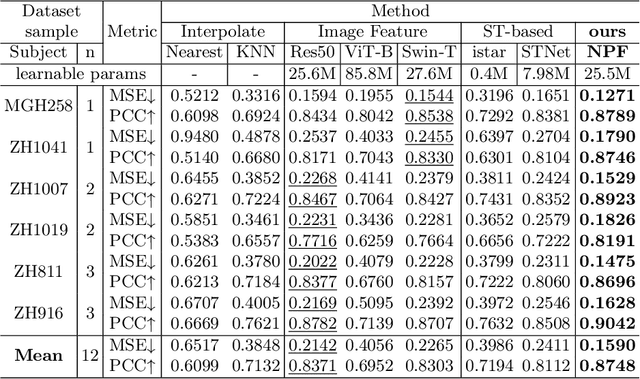


Abstract:Spatial proteomics maps protein distributions in tissues, providing transformative insights for life sciences. However, current sequencing-based technologies suffer from low spatial resolution, and substantial inter-tissue variability in protein expression further compromises the performance of existing molecular data prediction methods. In this work, we introduce the novel task of spatial super-resolution for sequencing-based spatial proteomics (seq-SP) and, to the best of our knowledge, propose the first deep learning model for this task--Neural Proteomics Fields (NPF). NPF formulates seq-SP as a protein reconstruction problem in continuous space by training a dedicated network for each tissue. The model comprises a Spatial Modeling Module, which learns tissue-specific protein spatial distributions, and a Morphology Modeling Module, which extracts tissue-specific morphological features. Furthermore, to facilitate rigorous evaluation, we establish an open-source benchmark dataset, Pseudo-Visium SP, for this task. Experimental results demonstrate that NPF achieves state-of-the-art performance with fewer learnable parameters, underscoring its potential for advancing spatial proteomics research. Our code and dataset are publicly available at https://github.com/Bokai-Zhao/NPF.
On-Demand Scenario Generation for Testing Automated Driving Systems
May 20, 2025Abstract:The safety and reliability of Automated Driving Systems (ADS) are paramount, necessitating rigorous testing methodologies to uncover potential failures before deployment. Traditional testing approaches often prioritize either natural scenario sampling or safety-critical scenario generation, resulting in overly simplistic or unrealistic hazardous tests. In practice, the demand for natural scenarios (e.g., when evaluating the ADS's reliability in real-world conditions), critical scenarios (e.g., when evaluating safety in critical situations), or somewhere in between (e.g., when testing the ADS in regions with less civilized drivers) varies depending on the testing objectives. To address this issue, we propose the On-demand Scenario Generation (OSG) Framework, which generates diverse scenarios with varying risk levels. Achieving the goal of OSG is challenging due to the complexity of quantifying the criticalness and naturalness stemming from intricate vehicle-environment interactions, as well as the need to maintain scenario diversity across various risk levels. OSG learns from real-world traffic datasets and employs a Risk Intensity Regulator to quantitatively control the risk level. It also leverages an improved heuristic search method to ensure scenario diversity. We evaluate OSG on the Carla simulators using various ADSs. We verify OSG's ability to generate scenarios with different risk levels and demonstrate its necessity by comparing accident types across risk levels. With the help of OSG, we are now able to systematically and objectively compare the performance of different ADSs based on different risk levels.
MAD-UV: The 1st INTERSPEECH Mice Autism Detection via Ultrasound Vocalization Challenge
Jan 08, 2025


Abstract:The Mice Autism Detection via Ultrasound Vocalization (MAD-UV) Challenge introduces the first INTERSPEECH challenge focused on detecting autism spectrum disorder (ASD) in mice through their vocalizations. Participants are tasked with developing models to automatically classify mice as either wild-type or ASD models based on recordings with a high sampling rate. Our baseline system employs a simple CNN-based classification using three different spectrogram features. Results demonstrate the feasibility of automated ASD detection, with the considered audible-range features achieving the best performance (UAR of 0.600 for segment-level and 0.625 for subject-level classification). This challenge bridges speech technology and biomedical research, offering opportunities to advance our understanding of ASD models through machine learning approaches. The findings suggest promising directions for vocalization analysis and highlight the potential value of audible and ultrasound vocalizations in ASD detection.
From Pixels to Gigapixels: Bridging Local Inductive Bias and Long-Range Dependencies with Pixel-Mamba
Dec 21, 2024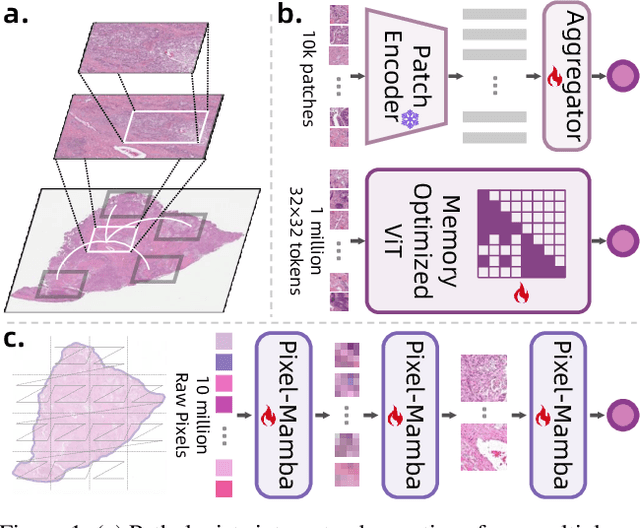
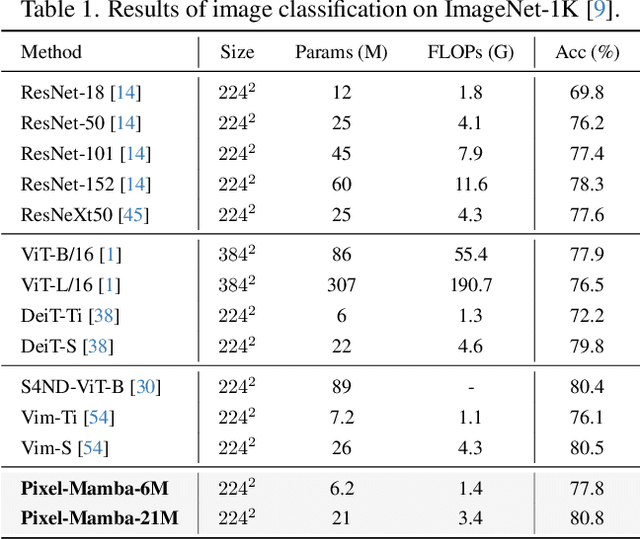
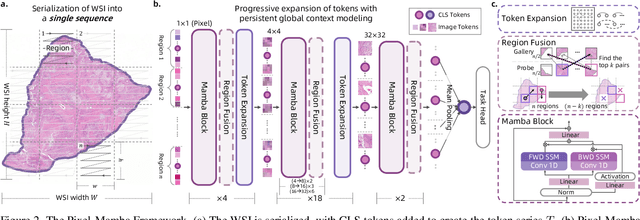
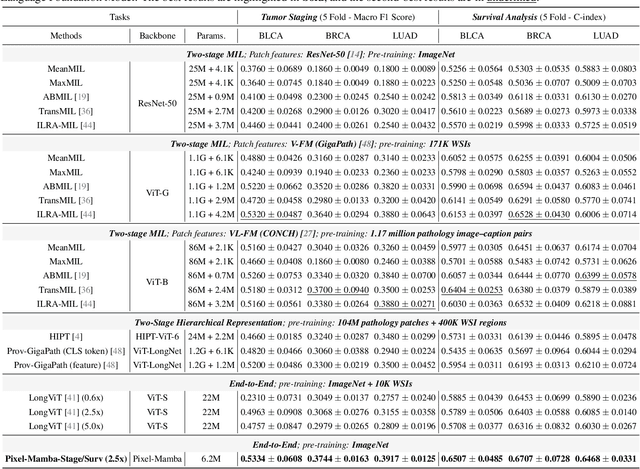
Abstract:Histopathology plays a critical role in medical diagnostics, with whole slide images (WSIs) offering valuable insights that directly influence clinical decision-making. However, the large size and complexity of WSIs may pose significant challenges for deep learning models, in both computational efficiency and effective representation learning. In this work, we introduce Pixel-Mamba, a novel deep learning architecture designed to efficiently handle gigapixel WSIs. Pixel-Mamba leverages the Mamba module, a state-space model (SSM) with linear memory complexity, and incorporates local inductive biases through progressively expanding tokens, akin to convolutional neural networks. This enables Pixel-Mamba to hierarchically combine both local and global information while efficiently addressing computational challenges. Remarkably, Pixel-Mamba achieves or even surpasses the quantitative performance of state-of-the-art (SOTA) foundation models that were pretrained on millions of WSIs or WSI-text pairs, in a range of tumor staging and survival analysis tasks, {\bf even without requiring any pathology-specific pretraining}. Extensive experiments demonstrate the efficacy of Pixel-Mamba as a powerful and efficient framework for end-to-end WSI analysis.
From Histopathology Images to Cell Clouds: Learning Slide Representations with Hierarchical Cell Transformer
Dec 21, 2024Abstract:It is clinically crucial and potentially very beneficial to be able to analyze and model directly the spatial distributions of cells in histopathology whole slide images (WSI). However, most existing WSI datasets lack cell-level annotations, owing to the extremely high cost over giga-pixel images. Thus, it remains an open question whether deep learning models can directly and effectively analyze WSIs from the semantic aspect of cell distributions. In this work, we construct a large-scale WSI dataset with more than 5 billion cell-level annotations, termed WSI-Cell5B, and a novel hierarchical Cell Cloud Transformer (CCFormer) to tackle these challenges. WSI-Cell5B is based on 6,998 WSIs of 11 cancers from The Cancer Genome Atlas Program, and all WSIs are annotated per cell by coordinates and types. To the best of our knowledge, WSI-Cell5B is the first WSI-level large-scale dataset integrating cell-level annotations. On the other hand, CCFormer formulates the collection of cells in each WSI as a cell cloud and models cell spatial distribution. Specifically, Neighboring Information Embedding (NIE) is proposed to characterize the distribution of cells within the neighborhood of each cell, and a novel Hierarchical Spatial Perception (HSP) module is proposed to learn the spatial relationship among cells in a bottom-up manner. The clinical analysis indicates that WSI-Cell5B can be used to design clinical evaluation metrics based on counting cells that effectively assess the survival risk of patients. Extensive experiments on survival prediction and cancer staging show that learning from cell spatial distribution alone can already achieve state-of-the-art (SOTA) performance, i.e., CCFormer strongly outperforms other competing methods.
Improving the Natural Language Inference robustness to hard dataset by data augmentation and preprocessing
Dec 10, 2024
Abstract:Natural Language Inference (NLI) is the task of inferring whether the hypothesis can be justified by the given premise. Basically, we classify the hypothesis into three labels(entailment, neutrality and contradiction) given the premise. NLI was well studied by the previous researchers. A number of models, especially the transformer based ones, have achieved significant improvement on these tasks. However, it is reported that these models are suffering when they are dealing with hard datasets. Particularly, they perform much worse when dealing with unseen out-of-distribution premise and hypothesis. They may not understand the semantic content but learn the spurious correlations. In this work, we propose the data augmentation and preprocessing methods to solve the word overlap, numerical reasoning and length mismatch problems. These methods are general methods that do not rely on the distribution of the testing data and they help improve the robustness of the models.
Adversarial Safety-Critical Scenario Generation using Naturalistic Human Driving Priors
Aug 07, 2024

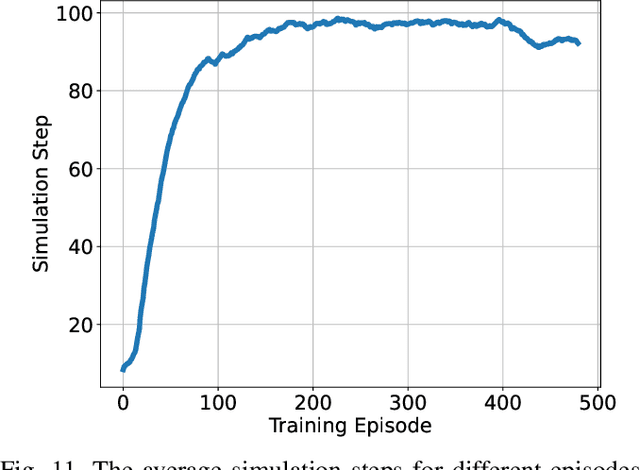
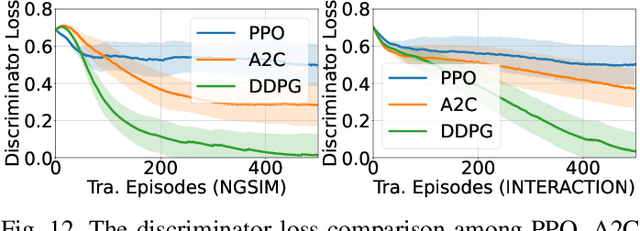
Abstract:Evaluating the decision-making system is indispensable in developing autonomous vehicles, while realistic and challenging safety-critical test scenarios play a crucial role. Obtaining these scenarios is non-trivial, thanks to the long-tailed distribution, sparsity, and rarity in real-world data sets. To tackle this problem, in this paper, we introduce a natural adversarial scenario generation solution using naturalistic human driving priors and reinforcement learning techniques. By doing this, we can obtain large-scale test scenarios that are both diverse and realistic. Specifically, we build a simulation environment that mimics natural traffic interaction scenarios. Informed by this environment, we implement a two-stage procedure. The first stage incorporates conventional rule-based models, e.g., IDM~(Intelligent Driver Model) and MOBIL~(Minimizing Overall Braking Induced by Lane changes) model, to coarsely and discretely capture and calibrate key control parameters from the real-world dataset. Next, we leverage GAIL~(Generative Adversarial Imitation Learning) to represent driver behaviors continuously. The derived GAIL can be further used to design a PPO~(Proximal Policy Optimization)-based actor-critic network framework to fine-tune the reward function, and then optimizes our natural adversarial scenario generation solution. Extensive experiments have been conducted in the NGSIM dataset including the trajectory of 3,000 vehicles. Essential traffic parameters were measured in comparison with the baseline model, e.g., the collision rate, accelerations, steering, and the number of lane changes. Our findings demonstrate that the proposed model can generate realistic safety-critical test scenarios covering both naturalness and adversariality, which can be a cornerstone for the development of autonomous vehicles.
* Published in IEEE Transactions on Intelligent Vehicles, 2023
Virtual Foundry Graphnet for Metal Sintering Deformation Prediction
Apr 17, 2024



Abstract:Metal Sintering is a necessary step for Metal Injection Molded parts and binder jet such as HP's metal 3D printer. The metal sintering process introduces large deformation varying from 25 to 50% depending on the green part porosity. In this paper, we use a graph-based deep learning approach to predict the part deformation, which can speed up the deformation simulation substantially at the voxel level. Running a well-trained Metal Sintering inferencing engine only takes a range of seconds to obtain the final sintering deformation value. The tested accuracy on example complex geometry achieves 0.7um mean deviation for a 63mm testing part.
LitSim: Conflict-aware Policy for Long-term Interactive Traffic Simulation
Mar 07, 2024



Abstract:Simulation is pivotal in evaluating the performance of autonomous driving systems due to the advantages in efficiency and cost compared to on-road testing. Realistic multi-agent behavior~(e.g., interactive and long-term) is needed to narrow the gap between the simulation and the reality. The existing work has the following shortcomings in achieving this goal:~(1) log replay offers realistic scenarios but leads to unrealistic collisions due to lacking dynamic interactions, and~(2) model-based and learning-based solutions encourage interactions but often deviate from real-world data in long horizons. In this work, we propose LitSim, a long-term interactive simulation approach that maximizes realism while avoiding unrealistic collisions. Specifically, we replay the log for most scenarios and intervene only when LitSim predicts unrealistic conflicts. We then encourage interactions among the agents and resolve the conflicts, thereby reducing the likelihood of unrealistic collisions. We train and validate our model on the real-world dataset NGSIM, and the experimental results demonstrate that LitSim outperforms the current popular approaches in realism and reactivity.
Bridging the Semantic-Numerical Gap: A Numerical Reasoning Method of Cross-modal Knowledge Graph for Material Property Prediction
Dec 15, 2023



Abstract:Using machine learning (ML) techniques to predict material properties is a crucial research topic. These properties depend on numerical data and semantic factors. Due to the limitations of small-sample datasets, existing methods typically adopt ML algorithms to regress numerical properties or transfer other pre-trained knowledge graphs (KGs) to the material. However, these methods cannot simultaneously handle semantic and numerical information. In this paper, we propose a numerical reasoning method for material KGs (NR-KG), which constructs a cross-modal KG using semantic nodes and numerical proxy nodes. It captures both types of information by projecting KG into a canonical KG and utilizes a graph neural network to predict material properties. In this process, a novel projection prediction loss is proposed to extract semantic features from numerical information. NR-KG facilitates end-to-end processing of cross-modal data, mining relationships and cross-modal information in small-sample datasets, and fully utilizes valuable experimental data to enhance material prediction. We further propose two new High-Entropy Alloys (HEA) property datasets with semantic descriptions. NR-KG outperforms state-of-the-art (SOTA) methods, achieving relative improvements of 25.9% and 16.1% on two material datasets. Besides, NR-KG surpasses SOTA methods on two public physical chemistry molecular datasets, showing improvements of 22.2% and 54.3%, highlighting its potential application and generalizability. We hope the proposed datasets, algorithms, and pre-trained models can facilitate the communities of KG and AI for materials.
 Add to Chrome
Add to Chrome Add to Firefox
Add to Firefox Add to Edge
Add to Edge